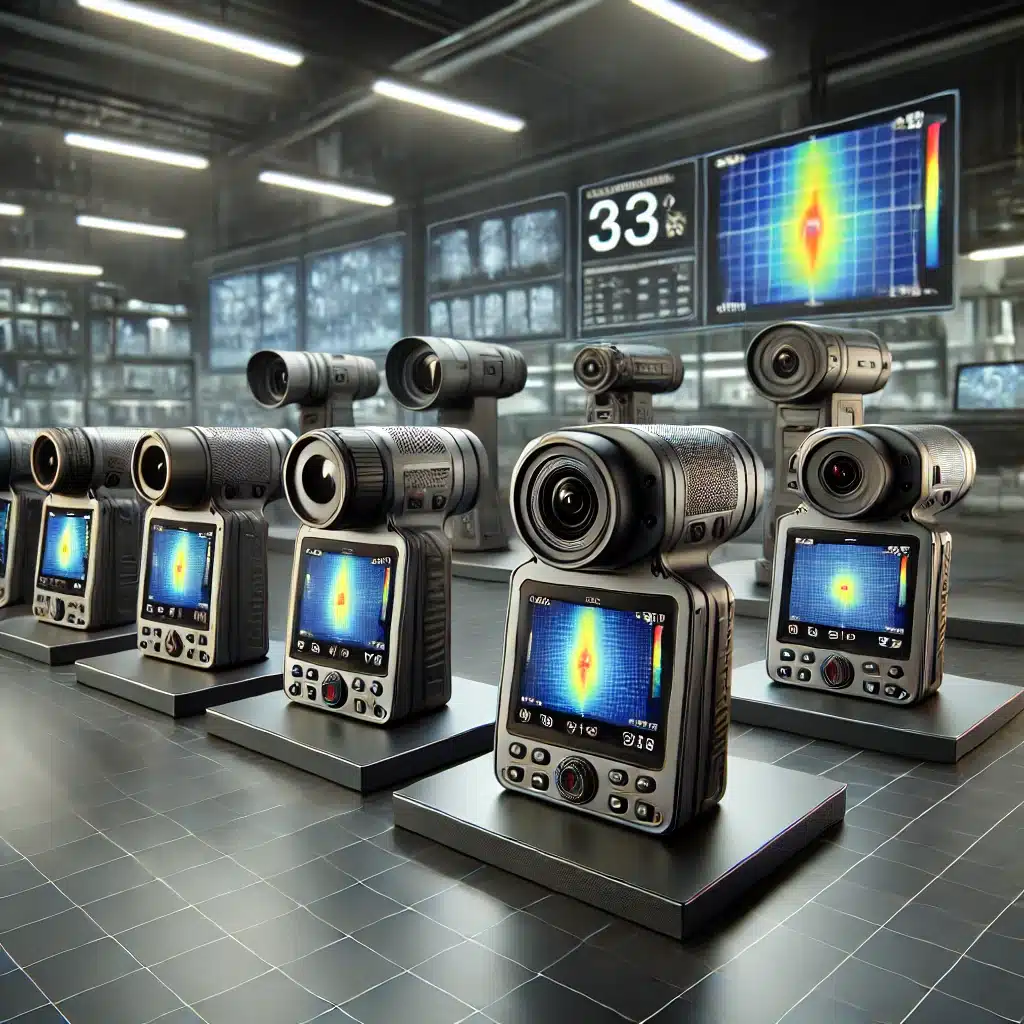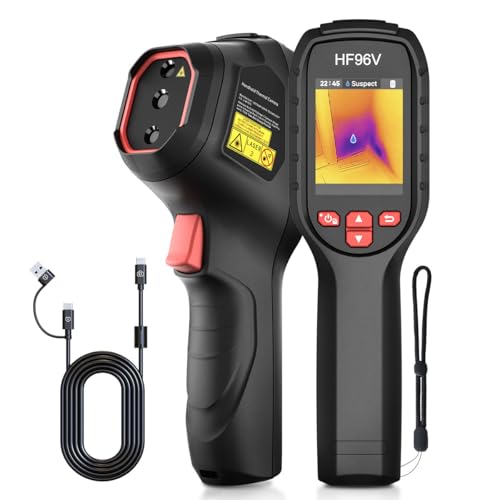
Thermal cameras have become indispensable tools for detecting heat signatures across various applications, from home inspections to outdoor adventures and professional use.
These devices provide precise thermal imaging, helping you see what’s invisible to the naked eye.
In this guide, we’ve reviewed the best 7+ thermal cameras, highlighting their cutting-edge features and performance to help you choose the perfect one for your needs.
Our Top Picks of The Best Thermal Cameras in 2025
- 【Enhanced Thermal Clarity】Start with 128×128 thermal imaging and enhance to 240×240 resolution with TISR technology for greater details. The wide 40°x 30° field of view and a 25Hz refresh rate deliver accurate, smooth thermal images—ideal for detailed inspections in homes and on electrical systems and machinery.
- 【Wide Application with Smart Alerts and Photograph】From underfloor heating to leak detection and electrical inspections, the TC004 Mini adapts to every challenge. When temperatures exceed preset levels, an on screen warning alerts you instantly while automatically capturing a photo to streamline your diagnostics. In addition, TC004 Mini also supports manual photo taking to help you record and solve problems, and the built-in 512MB eMMC storage can store up to 8,000 photos.
- Enhanced Clarity with 240×240 TISR Resolution: Equipped with TISR technology, the H128 infrared camera elevates your thermal imaging clarity from 128×128 to 240×240 resolution. With a thermal sensitivity of 40mk, it captures the slightest temperature differences. A frame rate of 25Hz ensures smooth, stutter-free imagery, providing you with a silky-smooth experience during inspections.
- Extended 24-Hour Battery Life: The H128 thermal imager’s built-in rechargeable battery offers up to 24 hours of continuous working time, allowing you to conduct inspections without worrying about power outages. With its intelligent auto-shutdown feature, battery life is maximized, ensuring your device is always ready when you need it most.
- 【Intelligent Scene Recognition with IntellFault】HF96 features HSFTOOLS’ unique IntellFault technology for automated scene detection. Powered by deep learning, it swiftly identifies water leaks and insulation gaps location, making thermal inspections simpler and faster. Download the latest firmware from the HSFTOOLS website to upgrade your device, then select “Scene” in the settings to explore its features. Note: No moisture readings.
- 【User-Friendly 3-in-1 Tool】 (1)The HF96 combines a thermometer, thermal camera & laser pointer in one device, maintaining your temp reading habit while adding real-time heatmap visualization. (2) User-friendly button control: power on, menu navigation, image capturing,video recording, and palette switching. (3)The package includes a manual, wrist strap, 2-in-1 USB-C to USB-A/C cable.
- Super Resolution Enhancement: The Flagfront YXI96 thermal camera is equipped with 240×240 super-resolution imaging technology, providing clearer images and capturing more details; A high frame refresh rate of 25Hz ensures a smooth inspection experience
- Temperature Alarm: This thermal infrared camera is equipped with a built-in temperature alarm function, which can detect abnormal high and low temperatures and quickly identify abnormal heat sources. Display the highest/lowest/center temperature on the screen, visually track the temperature of the heat source in real-time, and ensure efficiency during the inspection process
- 【Enhanced Thermal Clarity for Precise Inspections】The RT280 handheld thermal imaging camera features a 2.8-inch 320×240 LCD screen for smooth, detailed thermal visuals. Equipped with TISR technology, it enhances thermal image effective resolution from 120×90 to 240×180, enabling the capture of tiny temperature differences. Its 50°x 38° FOV and 25Hz frame rate deliver clear, smooth images, making it ideal for home inspections, electrical checks, mechanical fault diagnosis, and automotive engine inspections.
- 【Smart PC Analysis with 2D/3D & Temperature Insights】Easily transfer images from this thermal imager to a computer for advanced analysis. The included software supports point, line, and area temperature analysis, 2D/3D thermal imaging, and automatic report generation. Complex thermal data from this infrared cameras thermal imaging device is instantly transformed into actionable, shareable insights, helping you solve problems efficiently and professionally.
- 【Ultimate Clarity】 Featuring the HSFTOOLS Live Super Resolution algorithm, the F2W thermal imager takes thermal image enhancement as the resolution jumps from 256×192 detector resolution to an impressive 640×480 super resolution. Experience crystal-clear thermal imaging on an ultra-large 640×480 3.2″ LCD. The <40 mK sensitivity and 25 Hz high refresh rate provide HD and smooth thermal imaging for fast IR inspections without lag. Easily switch among 7 color palettes using the Down button.
- 【Advanced Intelligent Scene Detection]】The F2W thermal scanner features HSFTOOLS’ unique intelligent technology, IntellFault, along with the Pro Scene Color Alarm. It uses advanced deep learning to quickly detect potential water leaks and insulation voids. The Pro Scene automatically analyzes environmental data to detect and alert you to abnormal moisture or insulation issues. Designed for both beginners and experts, HSFTOOLS’ intelligent scene detection makes inspections faster and easier.
- 【Dual Cameras】Built-in 96×96 IR camera and 640×480 visible camera, the HF96V thermal imager offers 3 image modes (Fusion/Thermal/Visual) for enhanced detail and scene image contrast, helping locate anomalies more effectively. 7 selected color palettes allow you to flexibly choose the most appropriate color palette for different detection scenarios and purposes.
- 【Intelligent Scene Recognition with IntellFault】Featuring HSFTOOLS’ unique IntellFault technology for automated scene detection. Powered by deep learning, it swiftly identifies water leaks and insulation gaps, which makes thermal inspections simpler, faster and more reliable. Download latest firmware on HSFTOOLS Website to upgrade and select “Scene” in the setting to experience it.
- COMPATIBILITY: Infrared camera plugs directly into phone charging port and connects with iphones with USB-C (iphone 15 and newer)
- SUPER RESOLUTION: Vivid IR technology upscales the image to 240×180 from 80×60 for greater detail and clarity. Flir MSX technology merges thermal and visual images to enhance details in real time.
- UNIVERSAL USB-C COMPATIBILITY: As an upgraded version of TC002C, the TOPDON TC002C Duo now works seamlessly with all USB-C smartphones and tablets (iOS, Android & Windows), ensuring compatibility with the latest Apple & Android devices. Note: Not compatible with Mac device or Android 16 device temporarily
- SUPER RESOLUTION (TISR): The TOPDON TC002C Duo thermal camera enhanced 256×192 thermal imaging to reveal sharper details at 512×384 with TISR(TOPDON Image Super Resolution). It complemented by a 25Hz refresh rate and a high heat sensitivity of 40mK, ensure smooth, real-time heat tracking, perfect for dynamic environments
- High Resolution, Accurate Measurement: TOPDON TC004 Thermal Camera has 256×192 ultra-high resolution, thermal sensitivity <40mk, temperature resolution up to ±1°F, three temperature measurement modes center point / maximum temperature / minimum temperature, fast 25Hz frame rate and temperature range -4°F to 662°F, high resolution. Accurate measurement allows you to detect potential problems early and diagnose problems reliably!
- Free PC Software Upgrade: TOPDON TC004 Infrared Camera can be connected to a Windows PC (Not compatible with Mac) via USB for online analysis, real-time detection of object temperature changes, support for 3D imaging, point-line surface temperature measurement. Up to 32GB memory, support memory expansion, you can also stream the device in real time to a laptop or computer for offline temperature measurement, analyze the saved images, export data reports, and dig deeper into the data.
Why Thermal Cameras Are Essential for Detecting Heat Signatures
As someone who loves spending time outside, I’ve learned that spotting heat signatures can make a huge difference when you’re hunting, camping, or just wandering around the woods. Thermal cameras don’t look for regular light, instead, they sense infrared radiation. This means they can find anything warm in dark or tricky places. Picture this: areas with lots of heat show up as red, orange, or yellow on the screen, while places that are cooler show up as purple or blue. If it’s green, it’s about the same temperature as room air. So with a thermal camera in hand, you can find animals, navigate through thick woods at night, and even find someone who’s gone missing in the wild.
These nifty gadgets work by picking up on the heat that things give off, showing you colorful patterns that map out what you can’t see with your eyes. The magic happens when the lens grabs those invisible infrared waves and sends them to a special part of the camera. This then turns into electric signals and finally, the temperatures shine bright as day on your screen (RS Online). You’ll appreciate how handy they are for seeing animals at night or checking out how warm your tent is. They’re even great at spotting dangers in the wild like hot spots or escaping heat.
How We Selected the Best 7+ Thermal Cameras
When picking out top-notch thermal cameras, I dug deep into things that matter when you’re out and about. I sifted through tons of reviews, took advice from experts, and checked if the price matched the quality. Seeing clearly was top of the list, so I focused on cameras that give you a crisp picture. If you can see more detail, you can spot things farther away with no hassle. I also made sure these gadgets could handle rough weather and weren’t too much to lug around. You’ll want a camera that lasts long on a single charge too, especially on those long stretches away from outlets.
I rounded up a list of thermal cameras catering to various wallets and needs. Whether you’re a veteran hunter or just enjoy the great outdoors, there’s something in this list that’ll fit right with your adventures. You might even pair these cameras with some other outdoor gear. You see, using a thermal camera alongside, say, one of the best electric bikes for hunting or those best ultralight tents might just level up your outdoor game even more!
Best 7+ Thermal Cameras for Detecting Heat
FLIR TG165-X Thermal Camera
Features and Specs
- Resolution: 80 × 60 pixels
- Temperature Range: -13°F to 255°F
- Field of View: 50° × 38°
- Weight: 0.69 lb
Pros and Cons
| Pros | Cons |
|---|---|
| Easy to carry | Limited clarity |
| User-friendly | Restricted temp range |
Who It’s Best For
Perfect for those who like hiking and need a budget-friendly thermal camera for quick looks.
FLIR C5 Compact Thermal Camera
Features and Specs
- Resolution: 160 × 120 pixels
- Temperature Range: -4°F to 752°F
- Field of View: 41° × 32°
- Integrated WiFi: Yes
Pros and Cons
| Pros | Cons |
|---|---|
| WiFi for sharing | A bit bulky for pockets |
| Clearer thermal pics | A little expensive |
Who It’s Best For
Great for folks needing a handy thermal camera with WiFi for quick sharing and reports.
Seek Thermal RevealPro
Features and Specs
- Resolution: 320 × 240 pixels
- Temperature Range: -40°F to 626°F
- Field of View: 45° × 35°
- Battery Life: Up to 4 hours
Pros and Cons
| Pros | Cons |
|---|---|
| Sharp images | Bigger size |
| Long-lasting battery | No WiFi included |
Who It’s Best For
Ideal for adventure seekers who need crisp images and a battery that lasts through long days.
Pulsar Axion 2 XQ35 Thermal Monocular
Features and Specs
- Resolution: 640 × 480 pixels
- Temperature Range: -13°F to 220°F
- Field of View: 14° × 11°
- Weight: 0.67 lb
Pros and Cons
| Pros | Cons |
|---|---|
| Lightweight | Limits on temp range |
| Great image clarity | Costs more |
Who It’s Best For
Awesome for hunters and nature lovers who want portable yet powerful imaging.
FLIR E8-XT Thermal Imaging Camera
Features and Specs
- Resolution: 320 × 240 pixels
- Temperature Range: -4°F to 302°F
- Field of View: 45° × 34°
- Weight: 1.1 lb
Pros and Cons
| Pros | Cons |
|---|---|
| Excellent image quality | High price for hobbyists |
| Sturdy build | Heavier than others |
Who It’s Best For
Best for expert inspectors needing reliable thermal imaging for precise evaluations.
AGM Global Vision Asp-Micro TM160
Features and Specs
- Resolution: 160 × 120 pixels
- Temperature Range: -40°F to 752°F
- Field of View: 7° × 9°
- Battery Life: 8 hours
Pros and Cons
| Pros | Cons |
|---|---|
| Long battery life | Less detail in images |
| Easy to carry around | Fewer features |
Who It’s Best For
Great for campers needing a durable monocular with all-day battery power.
Seek ShotPRO Thermal Imaging Camera
Features and Specs
- Resolution: 320 × 240 pixels
- Temperature Range: -40°F to 626°F
- Field of View: 45° × 35°
- Weight: 0.8 lb
Pros and Cons
| Pros | Cons |
|---|---|
| Can record videos | Bulkier size |
| Fits many activities | Needs frequent recharging |
Who It’s Best For
Perfect for outdoor fans who crave a do-it-all camera for everything from camping to boating.
Choosing the right thermal camera depends on what you need it for. For more gear tips, check out our guides on best electric bikes for adventurers and top portable power stations.
Buyer’s Guide: How to Choose a Thermal Camera
When you’re on the hunt for a thermal camera, whether you’re an outdoor enthusiast, hunter, camper, hiker, or someone who loves fishing, a few features stand out as deal-breakers or makers. Don’t fret—I’ve laid out the essentials below to help you pick the right one.
What to Look For
See That Resolution and Range
A camera’s resolution is all about how clear those images turn out. You want to see the fox in the forest, not just a blob, right? Higher resolution cameras give you those crisp, fine details, making your wildlife watching or hunting a breeze.
| Feature | Description |
|---|---|
| Resolution | Crystal-clear images come from higher resolutions, meaning better and more precise temperature readings. |
| Detection Range | How far the camera can peek into heat sources. |
But hold up—thermal sensitivity, commonly known as NETD (Noise Equivalent Temperature Difference), is just as important. A more sensitive camera picks up even the tiniest heat hints. (Steele Industries)
Portability and Strength
Adventures mean moving around, so you don’t want to haul a brick. Lightweight cameras make those long trips more enjoyable, and a sturdy design holds up against unpredictable weather—rain, snow, you name it.
| Feature | Description |
|---|---|
| Weight | Light rigs mean happy campers or hikers. |
| Durability | Check if it’s built tough to handle Mother Nature’s feistiness—think waterproof, dustproof, and the whole shebang. |
How About Battery Life?
Picture this: the perfect shot lined up, and your camera goes dead. Nightmare, right? A solid battery life means you keep shooting or tracking without that worry hanging over you.
| Feature | Description |
|---|---|
| Battery Life | The longer it lasts, the less you have to think about charging breaks. |
| Battery Type | Decide if you want rechargeable or those easy-to-find regular batteries. |
Considering these factors will help you snag a great thermal camera for your adventures. Each feature matters in making sure your camera fits snugly with your nature-loving pursuits, especially when picking up on those sneaky heat signals.
FAQs
How Accurate Are Thermal Cameras?
Folks often ask me how spot-on thermal cameras are when checking out heat signatures. These nifty gadgets are made to sense infrared radiation coming from stuff, turning it into colorful thermographic pics that show different temperatures (Metoree).
Thermal cameras spit out temperature readings based on how much infrared heat they pick up. Generally, they’re pretty precise, but a bunch of things can mess with their accuracy, like how far away you are, what the weather’s like, and the stuff’s surface you’re measuring. Tweaking things like calibration can up their game, especially if you’re using them in more specialized settings.
Can Thermal Cameras Work in Daylight?
Absolutely, thermal cameras can do their thing in daylight. They capture infrared radiation, so they don’t care if it’s day or night out there. Handy, right?
Still, keep in mind that hot backgrounds—like sizzling surfaces under the sun—can sometimes mess with how clearly they see heat patterns. But don’t sweat it too much; they can still be super useful for outdoor stuff, like hunting or camping, where you need to see critters chilling out in the underbrush.
These gizmos also come in clutch for tracking down major heat sources, like when you’re finding fire hazards or spotting heat-conductive items tucked away behind walls (RS Online). They give you a leg up when wandering through nature, making sure you stay safe and have a keen eye during outdoor escapades.
Conclusion
Final Recommendations: Best Thermal Camera for Heat Detection
Choosing the right thermal camera can really amp up my outdoor escapades, whether I’m out hunting as the sun peeks over the horizon, camping under a blanket of stars, or fishing in the fading light. From what I’ve checked out—features good and bad—here are some thermal cameras I think are winners in the heat-detection game:
| Camera Model | Best For |
|---|---|
| FLIR TG165-X Thermal Camera | Beginners who want something easy to tote around. |
| FLIR C5 Compact Thermal Camera | Folks into small, everyday gadgets. |
| Seek Thermal RevealPro | Pros needing sharp, high-res images. |
| Pulsar Axion 2 XQ35 Thermal Monocular | Nature lovers looking for a handy monocular. |
| FLIR E8-XT Thermal Imaging Camera | The serious users that need top-notch features. |
| AGM Global Vision Asp-Micro TM160 | Those watching their wallet but not wanting to skimp on quality. |
| Seek ShotPRO Thermal Imaging Camera | If I’m after a high-performing, all-around option. |
Top Pick Recap
Out of all these cool options, my favorite is the FLIR E8-XT Thermal Imaging Camera. It brings together amazing sensitivity, standout resolution, and features that are a snap to use, perfect for anything from hunting trips to checking out my house. Its top-notch software makes it easy for me to tweak and pretty up my thermal images—which is super handy when I need to share slick reports with others.
No matter which thermal camera I settle on, I can’t ignore crucial stuff like resolution and detection range, how easy it is to carry around, and battery life. Every camera listed offers its own goodies to fit different types of outdoor adventures, making sure I find the one that’s just right for me.
If I want more info or advice on gear for the great outdoors, I might check into topics like best electric bikes for hunting and best ultralight tents, which could totally level up my outdoor escapades.












